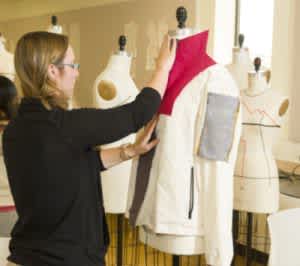Students Developing “Solar Powered” Clothing to Charge Electronics
OutdoorHub Reporters 05.09.12

One of these days, the outdoors will no longer be disconnected from the digital and electronic world. Colorado State University is helping to bring the world one step closer to that future. Students from the university’s Department of Design and Merchandising are making solar powered clothing prototypes which could be worn while biking, snowboarding, skiing or hiking and would simultaneously charge the user’s electronics using solar energy.
The team had many challenges to overcome. The solar panels had to be flexible, able to be washed, functional, and not degrade over time, all while the clothing itself had to be aesthetically appealing. The team also strove to use natural fibers like cotton, instead of previously developed petroleum-based materials which are said to contribute to pollution.
The project is still in development, but progressing along nicely. The CSU team was one of 45 teams chosen to compete in the U.S. Environmental Protection Agency’s People, Prosperity and the Planet student competition last April, although they did not win the award money.
Read more about the product from the press release published before the competition on April 19, 2012:
Colorado State University apparel design and production researchers and students are working to develop natural-fiber outdoor clothing that can charge MP3 devices, tablets, computers, GPS units and cell phones with built-in — but comfortable to wear — solar panels. The project is so impressive that it was recently selected to compete in a sustainability design competition in Washington, D.C., from April 21-23.
The project, funded by a $15,000 grant from the Environmental Protection Agency, intends to also reduce pollution on two fronts. First, the clothing will use the most recent research and technology to make natural fibers such as cotton and linen as outdoor savvy as other petroleum-based textiles which are heralded by outdoor enthusiasts for warmth, UV ray protection, comfort and moisture-wicking. Second, the clothing will provide a solar source of energy for electronic devices, reducing alkaline battery use.
Eulanda Sanders and Ajoy Sarkar, associate professors in the Department of Design and Merchandising, along with four students, are currently developing natural-fiber outdoor clothing prototypes that harvest energy while the wearer participates in outdoor activities.
“This project is unique in that there are no current apparel products that combine solar power with natural fibers,” said Eulanda Sanders, a professor in the Department of Design and Merchandising who specializes in apparel design and production. While a few solar-powered “smart” outdoor apparel items are on the market, they are functionally flawed with solar panels that are difficult to launder or wear and are not aesthetically pleasing.
The team is using only UV-treated natural fiber fabric, such as cotton or linen, rather than petroleum-based textiles, which contribute to pollution. The researchers have discovered that the right selection of fabric and weave, thickness, weight, dyeing and finishing of natural fabrics provides excellent protection from UV rays. The group has developed prototypes of three jackets, a vest and two helmets –one ski helmet with Blue tooth capabilities and one for possible military use.
“We believe this will fill a need in the market for the many environmentally-conscious outdoor enthusiasts,” Sarkar said. The overall goal is to develop natural, solar-powering clothing items with functionality, durability and comfort while also being aesthetically stylish.
Undergraduate apparel design students Logan Garey and Anna Rieder, merchandising student Jared Blumentritt and engineering student Erick Gauck, are collaborating to develop outdoor gear with solar panels.
Key factors in the success of these garments will include the cost and flexibility of the panels and strategic placement to maximize sun exposure. Comfortable and easy-to-launder panel attachment points and wiring also will be important design features. In the second phase of the project, they also are considering designs that could be later adopted by road construction workers.
The team will present their project and prototypes at the National Sustainable Design Expo in Washington, D.C. They will be among 45 teams selected from 150 team applications from across the country that were selected to compete in the U.S. Environmental Protection Agency’s People, Prosperity and the Planet student competition. If CSU students win, they’ll receive additional funding to market their idea.
The Department of Design and Merchandising is in the College of Applied Human Sciences.

